#diamantinasaurus
Text


And so here is the result of the Winton Formation stream!
Home of Australovenator, a bunch of sauropods and lots of other critters. Preserved in this formation are the animal of a coastal river system.



Have some detail shots as well
#sciart#paleoart#paleostream#palaeoblr#cretaceous#dinosaur#dinosaurs#pterosaur#sauropod#australovenator#winton formation#australia#diamantinasaurus
718 notes
·
View notes
Text
Links for propaganda.
Deltasaurus, a triassic temnospondyl amphibian

Diamantinasaurus, a cretaceous sauropod dinosaur

Dickinsonia, an ediacaran ah well yeah ummm ok probably animal
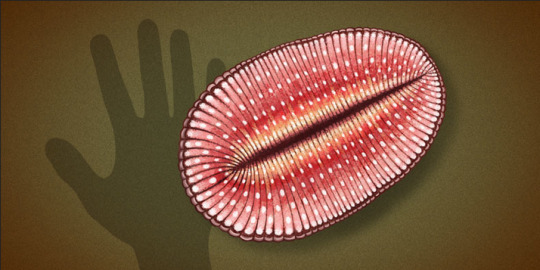
Diluvicursor, a cretaceous ornithopod dinosaur
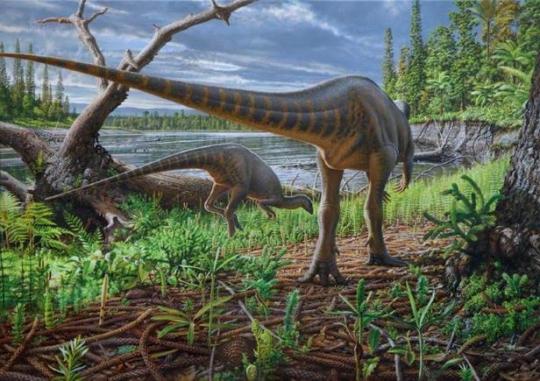
Diprotodon, a pleistocene diprotodontid marsupial
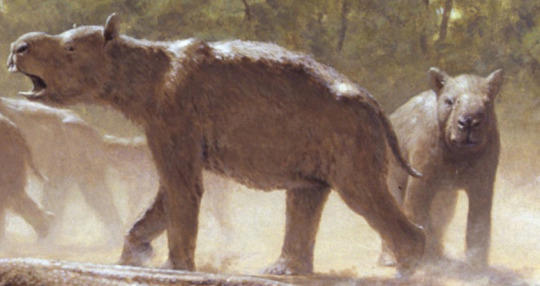
Dromornis, a cenozoic dromornithid bird
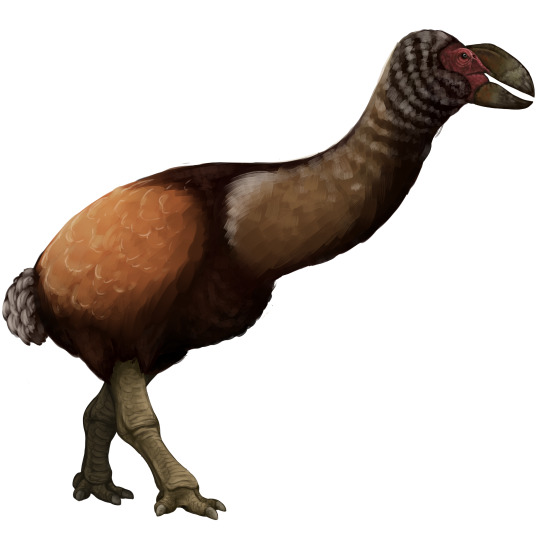
#please reblog#feel free to advocate for your favourite#palaeoblr#australian fossil alphabet thing#dinosaur#megafauna#deltasaurus#diamantinasaurus#dickinsonia#diluvicursor#diprotodon#dromornis
51 notes
·
View notes
Text

Redrew an old Diamantinasaurus drawing that I did.
#art#my art#digital art#paleoart#paleontology#palaeoblr#archosaurs#dinosaurs#sauropodomorphs#sauropods#diamantinasaurs#diamantinasaurus#queue
19 notes
·
View notes
Text
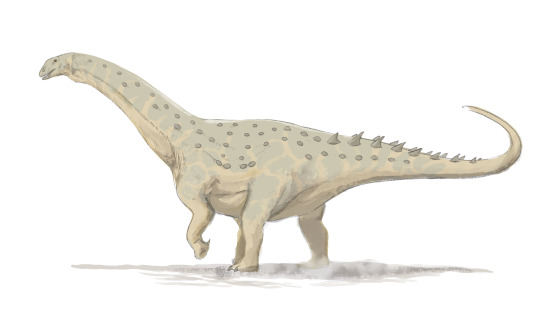
Day 4: diamantinasaurus matildae
11 notes
·
View notes
Text
Fossil Crocs of 2022
For what its worth, its been a great year for fossil Pseudosuchians, many of which didn't get a lot of attention because people always assume its just "another crocodile". We'll go through them by the order of appearance in the fossil record, or in other words oldest to youngest. Better grab some popcorn and the drink of your choice, cause this is going to be a long one.
Mambawakale
Starting off is Mambawakale ruhuhu (Ruhuhu Basin Crocodile Ancestor in Kiswahili) from the middle Triassic Manda Beds of Tanzania. The fossils for this guy had been known since at least the 1960s, after which it was named Pallisteria angustimentum, a name that was never officially published however. It was a large animal, its skull 75 centimeters long attached to what was likely an animal similar in build to what we think of for "rauisuchians", given that it sits at the base of Paracrocodylomorpha. The below life reconstructoin was done by the fantastic Gabriel Ugueto with Steve Irwin inserted in post by me, tho its not rigorously scaled it gives a general idea of the animal's size.
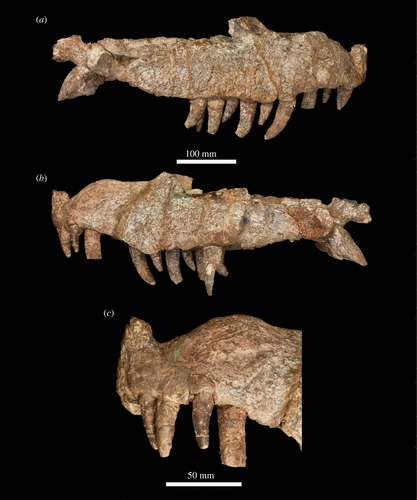
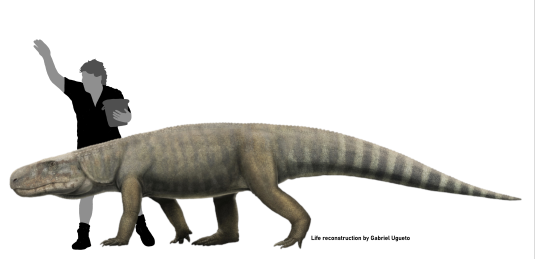
We can then skip over the Jurassic (no new crocs from that period) and straight into the Cretaceous, specifically the Albian some 100 million years ago.
Yanjisuchus
Yanjisuchus longshanensis (Yanji City Crocodile from the Longshan Hill) was a paralligatorid, a group of Neosuchians I fully admitt I'm not too well aquainted with. Its fossils, which include a partial skull, vertebrae osteoderms, ribs, parts of the shoulder girdle and front limbs, were discovered in the Longjing Formation in what is now north-eastern China.

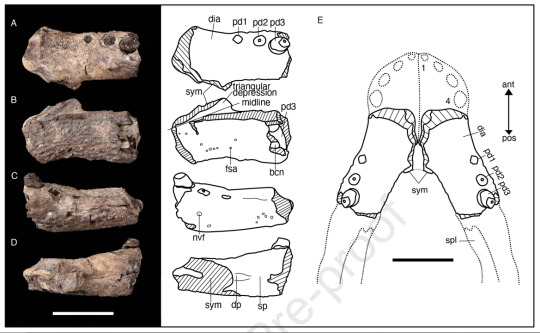
Confractosuchus
One I can decidedly talk more about is Confractosuchus sauroktonos (Lizard Eating Broken Crocodile) from the Australian Winton Formation, home to animals such as Isisfordia, Australovenator and Diamantinasaurus. The genus name refers to the fact that the skull is squashed to hell and back, but its the species name thats interesting. "Lizard eating" in this case refers to the fact that this 2.5 meter long basal Eusuchian was found with preserved stomach contents. Said stomach contents being the bones of a small ornithopod dinosaur as the press release art by Julius Csotonyi enthusiastically shows. The other image here not from the paper was drawn by Joschua Knüppe (@knuppitalism-with-ue ) showing a definitely more relaxed individual.

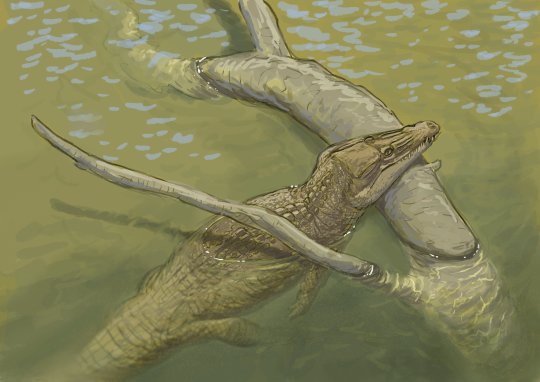

Eptalofosuchus
We did know about this guy for a bit longer as the pre-proof has been out since 2021, but lets include it anyways because I wasn't on Tumblr last year. Eptalofosuchus viridi (Green Seven Hills Crocodile) is not a crocodile in the strict sense but a Notosuchian, a cousin to the more typical Neosuchians. This animal is known from a single distinct lower jaw that belonged to a rather small creature. Among Notosuchians, Eptalofosuchus is most closely related to "advanced Notosuchians", specifically Sphagesauridae. We also know that it wasn't alone, as described alongside it are fossils of an unnamed baurusuchid (a large carnivore) and a peirosaurid, a more basal Notosuchian. Finally, both parts of the scientific name allude to the Uberaba Formation, specifically the nickname of Uberaba being “the city of the seven hills” and the green color of the sediments there. Life reconstruction of the little guy was done by the always incredible Júlia d'Oliveira.
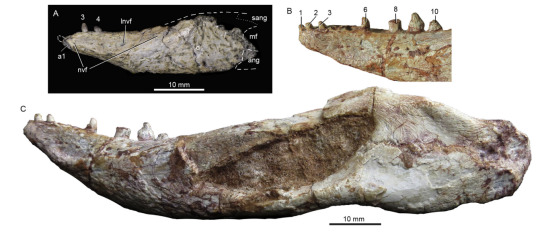
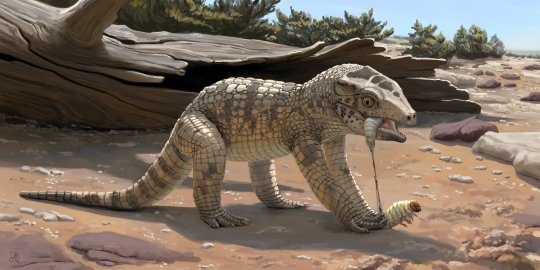
Titanochampsa
Sticking to South America we have Titanochampsa iorii (Ior's Titan Crocodile). A significant find no doubt tho with an estimated size between 2.98–5.88 m (sizable I admitt) based on very scant remains perhaps a little bit hasty. Alas we only have the skull table of this animal, so the precise size can still vary as you can see. But it is still a fascinating one due to the fact that its the ONLY non-Notosuchian from the Bauru Group. Cretaceous South America is almost synonymous with these mostly terrestrial crocodyliforms but surprisingly lacking a diverse semi-aquatic croc fauna. Being at the very least a Neosuchian, possibly Eusuchian, Titanochampsa seems to have filled this niche. Given that the big terrestrial Baurusuchids had relatively weak bites and reached a length of at most 4 meters, this presents an interesting contrast with the strong bite force of the potentially larger semi-aquatic Titanochampsa. And would you look at that, press release art by Júlia once again.
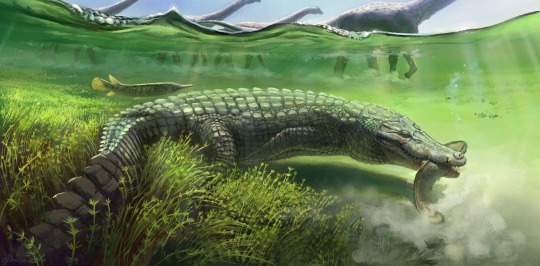

Eurycephalosuchus
One final croc for the Mesozoic, Eurycephalosuchus gannanensis is an animal I covered very recently so I'll keep things brief. Stemming from the Maastrichtian Hekou Formation in south eastern China, Eurycephalosuchus was a very small species of orientalosuchine. Orientalosuchina is recovered as a group of early alligatoroids in the paper, tho talking to Adam Yates (who's croc phylogeny is my go-to) there is a chance they might be closer to crocodiloids. Regardless, Eurycephalosuchus was a small animal with large teeth towards the front of the skull, blunt teeth in the back and an overall very short face (tho there is slight compression so its not 1:1 like the fossil). Over on twitter people started comparing it to DnD Kobolds, leading to the below artwork by Manusuchus (@ mmujicam2000; full body of course highly speculative lmao)
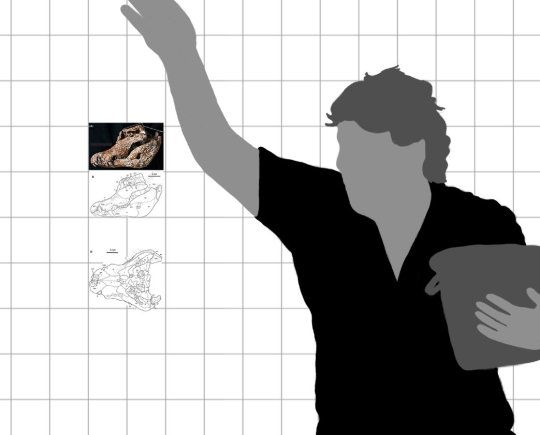

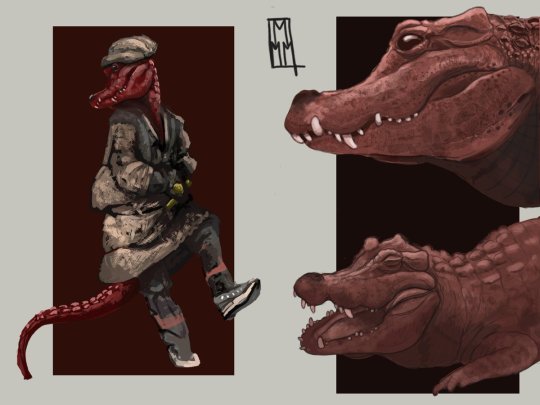
Qianshanosuchus
Following the cataclysm that was KPG, crocs held on and in China we next meet Qianshanosuchus youngi (Young's Qianshan Basin Crocodile). It's another tricky one. While important as being the first crocodyloid from Paleocene China, the material, as you could guess based on the tiny size, is that of a juvenile (I now realize this being kinda ironic given the small but adult croc above). So the phylogeny is hard to nail down and gave different results. Still it could hold significance in our understanding how crocodyloids spread around the world and entered Europe after KPG. Below a quick comparison of the material with my hand.

Coming up a duo of two new species but not new genera, I also didn't really go deep into their publication as with some of the others so I'll try to stay brief
Maomingosuchus acutirostris
Maomingosuchus acutirostris (Acute Snouted Maoming Crocodile) is a new species of the already established genus Maomingosuchus from China. This new species however, differentiated amongst other things by having a pointed, not rounded, premaxilla stems from the Eocene of northern Vietnam. The skull is about 55 cm long giving us a medium sized tomistomines. Like Qianshanosuchus, M. acutirostris could have implications for the dispersal of crocodilians, in this case the spread of tomistomines from Europe to Asia, which the authors suggest happened thrice. That being said it should be noted that, between the two main ideas of what tomistomines are, the paper goes with them being a sister group to crocs and unrelated to modern gharials as Lee and Yates suggest (the later idea like I said I am more drawn towards).


Diplocynodon kochi
Another new species in a familiar genus, Diplocynodon kochi (Koch's Double Dog Tooth) is the latest in a long list of Diplocynodon species, a genus of alligatoroid very prominent in the Paleogene of Europe. This newest species from Transylvania is known from some well preserved skull material and was recovered as being one of the most derived members of its genus. With a size of 1.76 meters it was a medium sized Diplocynodon species and small by our modern standards. What is interesting is that the fossilw as recovered from shallow marine sediments. This is unusual in so far that alligatoroids are not especially known for their salt tolerance. Tho there's exceptions like Deinosuchus, alligators usually don't venture into salt water unlike crocodiles. Still, given the shallow water and the ability of large adult Mississippie Alligators to tolerate brackish water, it might have occasionally entered coastal waters. It is noted that the skull is in such good condition that it couldn't have been transported for a very long time.
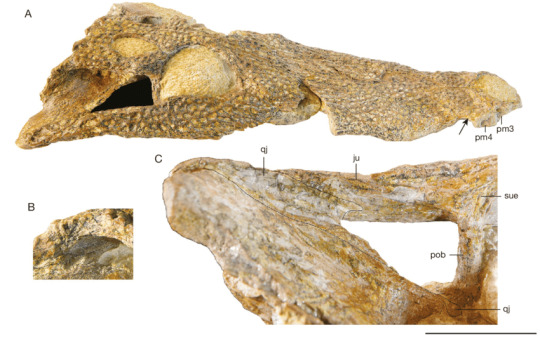
Kinyang
Back to new genera we got Kinyang (derived from various Nilotic terms for crocodile), a genus of "giant" dwarf crocodile from the Miocene of Kenya. Now this guy doesn't just introduce one new species but two: Kinyang mabokoensis (Maboko Island Crocodile) and Kinyang tchernovi (Tchernov's Crocodile). Occuring in western and northern Kenya, Kinyang was a prime example over the prominence osteolaemines (dwarf crocodiles) had in the early Cenozoic prior to the takeover of crocodylines. Kinyang was surprisingly large and had a robust, blunt skull with several traits clearly setting it apart from any modern species. Still there is some clues that could be taken. Given the robust nature and more widened skull rather than V-shaped, its likely that it went after prey as big or even bigger than itself. They appear to have inhabited the shores of lakes located in open forests and woodlands. Alas this might have been their doom too. Osteolaemines are known to build nests made of foliage and with Africa growing increasingly dryer around this point in earths history, both change in prey and environment could have been factors that drove the dwarf crocodiles into the rainforests they inhabit today while the more dry resistant Crocodylus took over their rolle in the grasslands. The first image shows all three known skulls, the second is a quick composite of the cranium and mandible of K. mabokoensis I put together before the third image was published (ironic) by Christopher Brochu.
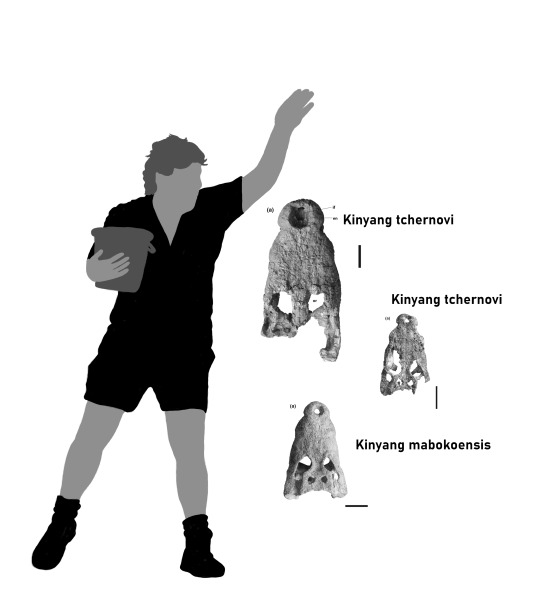
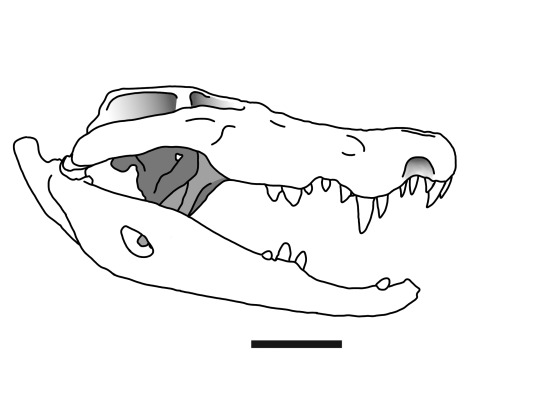

Almost done, only two more to go.
Sacacosuchus
On the other side of the world, specifically the Sacaco locality of Peru's Pisco Formation (among others) we have Sacacosuchus cordovai (Córdova's Sacaco Crocodile). A medium sized and longirostrine "tomistomine" gharial, here is where we come in conflict between the crocodylid and gavialoid model of what these guys are. Earlier with Maomingosuchus you had the idea that tomistomines were related to crocodylids, well here we have tomistomines being a paraphyletic group leading up to derived gharials. There is some significance to Sacacosuchus for seemingly showing that gharials entered South America on two separate occassions, but imo that's not the coolest thing about it. No instead I prefer to talk about the fact that its not just a marine gharial, living in the coastal waters of the Pacific, but that it coexisted with a second gharial showing perfectly how they specialise in different things. While the contemporary Piscogavialis was notably larger (about 7 meters) it had a very narrow and long snout, better adapted at catching fish. Sacacosuchus meanwhile was only 4.3 meters long, but with much more robust jaws, showing that it was much more of a generalist than its relative. This is well shown in the reconstruction by Javier "Canelita" Herbozo, tho it doesn't show the immense size difference. The third iamge shows Rodolfo Salas-Gismondi with the material and the fourth illustration by Gabriel Ugueto does not feature Sacaco, but the much more gracile Piscogavialis.




Hanyusuchus
The final one, Hanyusuchus sinensis (Han Yu's Crocodile from China) is the youngest crocodile described this year. How young? Well the OLDEST records of the species date to the Chinese Bronze Age, 4.000 BC, while the most recent records indicate that it went extinct in the 15th century. Hanyusuchus is a large tomistomine with a length between 5.43–6.19 meters and, if historical reports are to be believed, a big appetite. Stories tell of large crocodiles in Southern China attacking livestock, deer, boats and even killing humans while other reports suggest that these animals were used to fill moats and fed with prisoners. Despite appearing relatively narrow snouted, people often underestimate just how dangerous such animals could be. Even the modern false gharial has reports of it attacking and eating humans. Unsurprisingly, in addition to spawning some unique folklore (like crocodiles turning into tigers during autumn), this lead to humans attacking and killing these animals in retaliation. Fossils from the Bronze Age bear the clear marks of human attacks with cut marks focused around the animals head and the neck. Given the age of this material humans likely used bronze axes to kill and decapitate Hanyusuchus, drying their heads afterwards. Things didn't get better later in history. Han Yu, poet and politician and namesake of the genus, once demanded that the crocodiles leave the Han River delta before threatening to kill them. Later in history soldiers were sent to kill them in masses to avenge the death of a child. Eventually all of this, coupled with habitat loss, lead to the extinction of Hanyusuchus a mere 600 years ago. The below reconstructions were done by Hikaru Amemiya and Joschua Knüppe respectively.


And that is basically every crocodile officially published in 2022 (I think). Personally, I think its been a fantastic year for Pseudosuchian taxa, with some unique and fascinating additions.
#crocodiles#palaeoblr#mambawakale#hanyusuchus#sacacosuchus#kinyang#qianshanosuchus#eurycephalosuchus#diplocynodon kochi#maomingosuchus acutirostris#titanochampsa#confractosuchus#eptalofosuchus#yanjisuchus#prehistory#paleontology#pseudosuchia#steve irwin for scale#2022
173 notes
·
View notes
Text
OK sauropodomorph poll slightly obscure
5 notes
·
View notes
Text
Episode 441: Ankylosaurs in Antarctica and sauropods in Australia
I Know Dino Podcast Episode 441: Ankylosaurs in Antarctica and sauropods in Australia. Plus Brian Curtice from @Fossilcrates joins us to talk about his work on sauropods and other dinosaurs from all over the world.
Episode 441: Ankylosaurs in Antarctica and sauropods in Australia. Plus Brian Curtice joins us to talk about his work on sauropods and other dinosaurs from all over the world.
News:
New Antarctic osteoderms helps show how nodosaurids survived in such a hostile environment. source
A Diamantinasaurus skull helps show the connection between titanosaurs on multiple continents…

View On WordPress
0 notes
Text
A rare, 95-million-year-old titanosaur skull found in Australia
A rare, 95-million-year-old titanosaur skull found in Australia, An artist’s illustration of Diamantinasaurus matildae’s head. This sauropod lived in Australia 100 million years ago. Elena Marian/Australian Age of Dinosaurs Museum of Natural HistoryThese giant sauropods would’ve been part…, 2023-04-14 15:00:00,
These giant sauropods would’ve been part of the family that includes the largest…
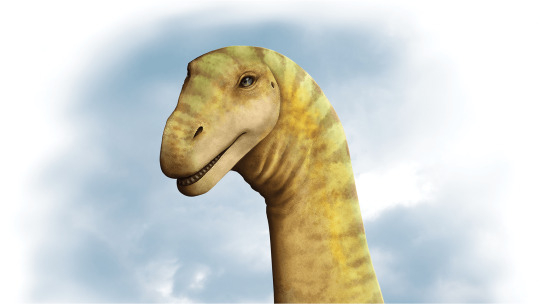
View On WordPress
0 notes
Text
Rinvenuto in Australia un cranio quasi completo di titanosauro
Ricostruzione grafica della testa di Diamantinasaurus matildae.
I dinosauri sauropodi titanosauri erano diversificati e abbondanti durante tutto il Cretaceo, con una distribuzione globale. Tuttavia, poche specie di titanosauri sono rappresentate da più scheletri, per non parlare dei crani. Il Diamantinasaurus matildae, proveniente dalla Formazione Winton del tardo Cretaceo del Queensland, in…

View On WordPress
0 notes
Text
The Qld icon takes a heavyweight in the title fight but only one appears as State Fossil
Tourism Minister Stirling Hinchliffe said choosing the iconic dinosaur as the state’s fossil symbol would drive more outlying tourism.
“Everyone loves dinosaurs, they generate millions of dollars for the visitor economy and we want to see the Queensland Outback continue to grow as Australia’s ancient capital,” he said.
Statue of Mutaburrasaurus at Muttaburrasaurus Interpretation Center in Muttaburra.attributed to him:Lisa Alexander
“That’s why the Palaszczuk government is investing in a dinosaur tourism roadmap to highlight the best prehistoric Queensland experiences.”
The CEO of the Queensland Museum Network, Dr Jim Thompson, said that while all 12 candidates were worthwhile fossils, he was pleased with the selection of the museum’s dinosaur.
loading
“Mutt, as people affectionately call him, is one of the most complete skeletons of an Australian dinosaur, a great ambassador for paleontology and dinosaur history,” he said.
Dr Scott Hocknall, a paleontologist at the Queensland Museum, credits Mott for sparking his interest in the field.
“I started volunteering at the Queensland Museum as a kid 30 years ago and Mutaborasaurus was the first dinosaur fossil I worked on,” he said.
“I used to dig dinosaurs as a kid, but now I do for real, and I can thank Motaborasaurus for that.”
A fossil was added to the state by a petition last year from the Australian Dinosaur Age Museum, in the remote Queensland town of Winton, which suggested the fossil. Diamantinasaurus matildaea massively built titanosaur, becoming an official state fossil.
Diamantinsaurus He came in third place in the poll with 977 votes.
In total, 12 contenders were brought up for the audience to decide on, including Kronosaurus queenslandicusfrom ancient aquatic reptiles, Obdurodon dicksoniearly platypus with teeth, and Lovillea wintonensisOld flower.
Muttaburrasaurus was a plant-eating dinosaur that lived in northeastern Australia over 100 million years ago during the early Cretaceous period.
The partial skeleton was first discovered in 1963 by local shepherd Doug Langdon on an estate near the remote Queensland town of Muttaburra.
It was officially named Mutaborasaurus to find me by paleontologists at the Queensland Museum in 1981 in honor of Mutapura and Langdon.
New South Wales, Western Australia and South Australia have official state fossils – two ancient fish and an ancient sea worm.
Source link
Originally published at Melbourne News Vine
0 notes
Photo

Only 1 days left... #cantwait #excited #preview #staytuned #dinosaur #diamantinasaurus #dictionaryofdinosaurs #dinosaurs #dinosaurbook #illustration #illustrationart #vectorart #instaart #book #bookstagram #childrensbooks #childrensbookillustration #dieterbraun #brauntown #dieterbraunillustration @quartokids #wideeyededitions @natural_history_museum #dictionary https://www.instagram.com/p/BodyeaOBNE4/?utm_source=ig_tumblr_share&igshid=114crksmnivf7
#cantwait#excited#preview#staytuned#dinosaur#diamantinasaurus#dictionaryofdinosaurs#dinosaurs#dinosaurbook#illustration#illustrationart#vectorart#instaart#book#bookstagram#childrensbooks#childrensbookillustration#dieterbraun#brauntown#dieterbraunillustration#wideeyededitions#dictionary
4 notes
·
View notes
Text
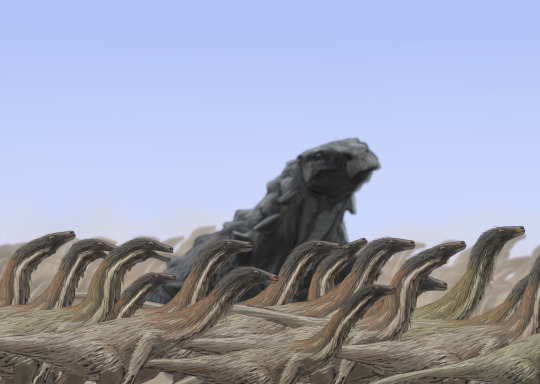
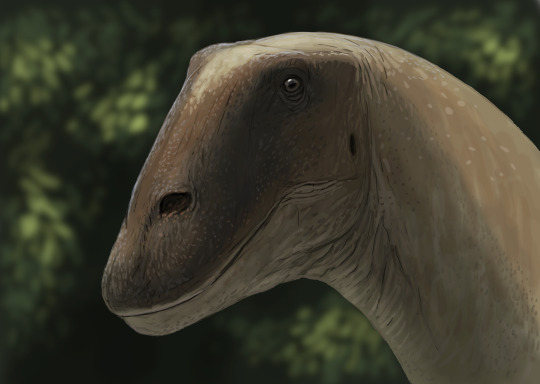
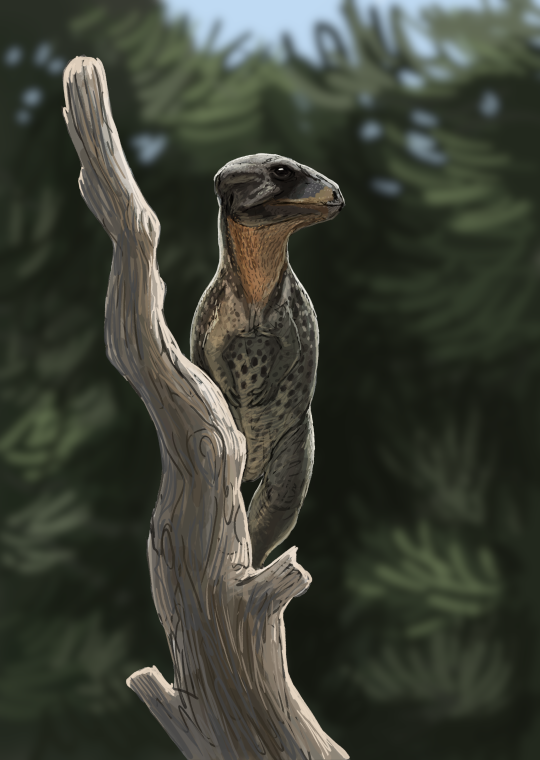
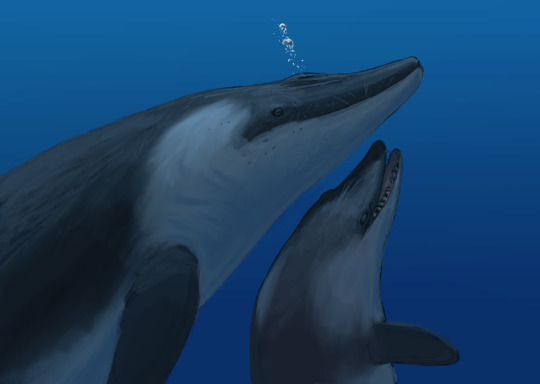
Results from the #paleostream
Falcarius, Diamantinasaurus, Platytholus and Coronodon (again :P )
#paleoart#sciart#dinosaurs#whale#coronodon#sauropod#therizinosaur#falcarius#diamantinasaurus#paleostream#palaeoblr#cretaceous#dinosaur
309 notes
·
View notes
Text
Australotitan cooperensis Hocknull et al., 2021 (new genus and species)

(Humerus [upper arm bone] of Australotitan cooperensis, shown partially restored to its original shape [H], under ambient occlusion [I], under natural light [R], and as a colored schematic [S], from Hocknull et al., 2021)
Meaning of name: Australotitan = southern titan; cooperensis = from the Cooper-Eromanga Basin, Cooper Creek system, and "Cooper Country"
Age: Late Cretaceous (Cenomanian–Turonian?)
Where found: Winton Formation, Queensland, Australia
How much is known: Partial skeleton of one individual including bones from the hips and all four limbs; fragmentary limb bones and vertebrae are known from other individuals.
Notes: Australotitan was a titanosaurian sauropod and the largest dinosaur known from Australia. It was comparable in size to other giant titanosaurs such as Dreadnoughtus. The type (name-bearing) specimen of Australotitan has been nicknamed "Cooper" after Cooper Creek, which runs close to where the fossils were discovered.
Three other sauropods have been described from the Winton Formation (Diamantinasaurus, Savannasaurus, and Wintonotitan), though it is unclear whether any of them lived at the same time as one another or with Australotitan. Some evidence suggests that all of these Winton Formation sauropods may have been closely related, but support for this hypothesis is currently still limited.
Reference: Hocknull, S.A., M. Wilkinson, R.A. Lawrence, V. Konstantinov, S. Mackenzie, and R. Mackenzie. 2021. A new giant sauropod, Australotitan cooperensis gen. et sp. nov., from the mid-Cretaceous of Australia. PeerJ 9: e11317. doi: 10.7717/peerj.11317
92 notes
·
View notes
Text

Day 4- Diamantinasaurus
Prompts
#art#my art#digital art#paleoart#dinovember#paleontology#palaeoblr#dinosaurs#sauropodomorphs#sauropods#titanosaurs#diamantinasaurus
19 notes
·
View notes
Text
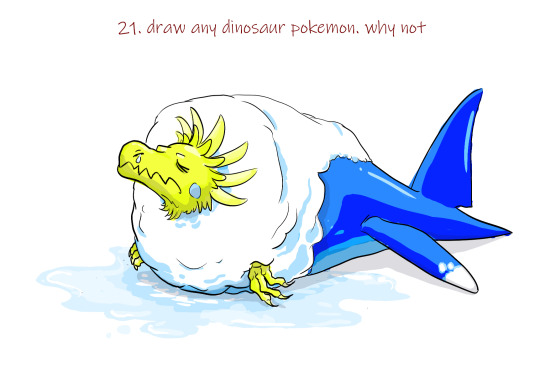
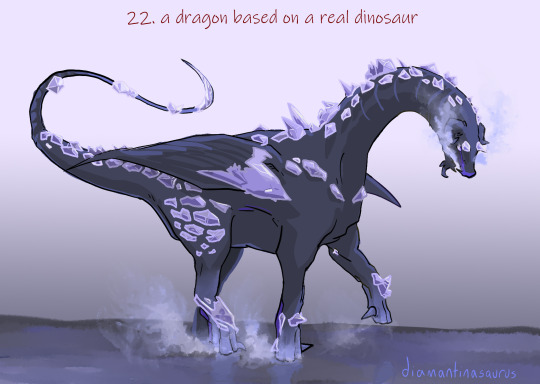
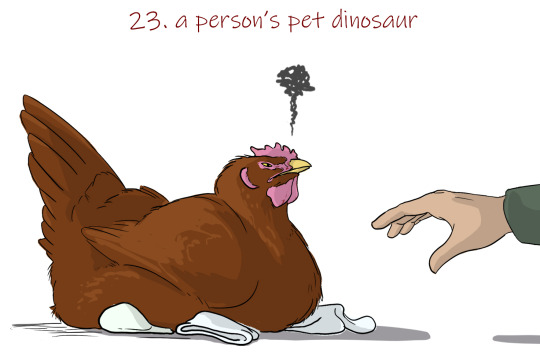






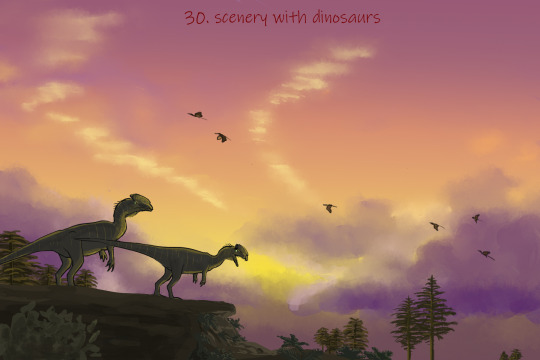
All done! Final part of the 30 day dino challenge
#dinosaurs#arctozolt#diamantinasaurus#baryonyx#30 day dino challenge#didelphodon#diplodocus#therizinosaurus#troodont#adelie penguin#dilophosaurus
71 notes
·
View notes
Photo
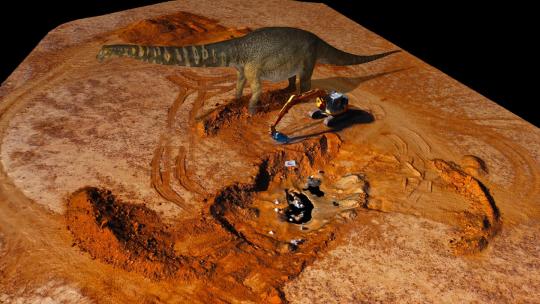
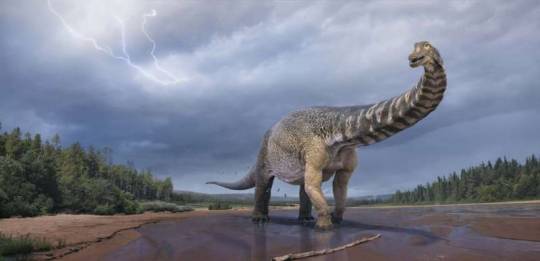

Meet Australia's largest dinosaur -- Australotitan, the southern titan! What's as long a basketball court, taller than a b-double and has just stomped into the record books as Australia's largest dinosaur? It's time to meet Australotitan cooperensis - a new species of giant sauropod dinosaur from Eromanga, southwest Queensland. Australotitan, "the southern titan", has been scientifically described and named by Queensland Museum and Eromanga Natural History Museum palaeontologists. It is estimated to have reached a height of 5-6.5 metres at the hip and 25- 30 metres in length and sits within the top 10-15 largest dinosaurs world-wide, representing Australia's entry into the largest species to have ever walked the Earth. The fossilised skeleton was originally nicknamed 'Cooper' after Cooper Creek, when first discovered in 2007 by the Eromanga Natural History Museum. It now represents the largest species of dinosaur ever found in Australia. The scientific publication marks a seventeen-year long culmination of the joint effort between Queensland Museum and Eromanga Natural History Museum palaeontologists, fossil preparators, geologists, and countless volunteers. "Australotitan adds to the growing list of uniquely Australian dinosaur species discovered in Outback Queensland, and just as importantly showcases a totally new area for dinosaur discovery in Australia," Dr Hocknull said. "To make sure Australotitan was a different species, we needed to compare its bones to the bones of other species from Queensland and globally. This was a very long and painstaking task." Dinosaur bones are enormous, heavy and fragile, and are kept in museums 100s-1000s of kilometres apart, making scientific study very difficult. For the first time, the team used new digital technology to 3-D scan each bone of Australotitan and compare them to the bones of its closest relatives. These scans will form part of the museum's digital collection that is powered by Project DIG, a partnership between Queensland Museum Network and BHP. "The 3-D scans we created allowed me to carry around 1000s of kilos dinosaur bones in a 7kg laptop. Better yet, we can now share these scans and knowledge online with the world," Dr Hocknull said. The study found that Australotitan was closely related to three other Australian sauropods that lived during the Cretaceous Period (92-96 million years ago). "We compared the three species found to the north, near Winton, to our new Eromanga giant and it looks like Australia's largest dinosaurs were all part of one big happy family. "We found that Australotitan was the largest in the family, followed by Wintonotitan with big hips and long legs, whilst the two smaller sauropods, Diamantinasaurus and Savannasaurus were shorter in stature and heavily-set." Dr Hocknull said along with the description of Australotitan, the study has also revealed a swathe of new discoveries in the area awaiting full scientific study. "Over the last 17-years numerous dinosaur, skeletons have been found, including one with an almost complete tail. The discovery of a rock-shelf, almost 100 metres long, represents a sauropod pathway, where the dinosaurs walked along trampling mud and bones into the soft ground," Dr Hocknull said. "Discoveries like this are just the tip of the iceberg. Our ultimate goal is to find the evidence that tells the changing story of Queensland, hundreds of millions of years in the making. A grand story all scientists, museums and tourists can get behind." Minister for Arts Leeanne Enoch said the exciting new discovery helps to cement Queensland as Australia's dinosaur capital. "Discoveries like Australotitan tell the story of a time when dinosaurs roamed Queensland," Minister Enoch said. "Queensland Museum experts have been on the ground, sharing their knowledge with regional museums and helping to preserve and better understand the diverse paleontological hi story of our state. "These unique outback discoveries are supporting Queensland as we deliver our economic recovery plan creating local jobs in regional and cultural tourism." Robyn Mackenzie, General Manager of Eromanga Natural History Museum said it's an exciting culmination of a major amount of work. "Finding Cooper has changed the course of our lives and led to the establishment of the Eromanga Natural History Museum," Ms Mackenzie said. "Working with Queensland Museum to formally describe Cooper has helped put our little town of Eromanga in Quilpie Shire South West Qld on the map. Australotitan is just the start, we have many more discoveries awaiting full scientific study. "It's amazing to think from the first bones discovered by our son, the first digs with the Queensland Museum, through to the development of a not-for-profit museum that runs annual dinosaur digs, all have helped us to get to this point, it's a real privilege." Queensland Museum Network CEO Dr Jim Thompson said this represented the first dinosaur discovery in this corner of south-west Queensland. "In the early 2000s Australia was at the beginning of a dinosaur-rush,with a number of significant new species of dinosaurs and megafauna being discovered in the past 20 years. Australia is one of the last frontiers for dinosaur discovery and Queensland is quickly cementing itself as the palaeo- capital of the nation - there is still plenty more to discover," Dr Thompson said. "I am proud that Queensland Museum palaeontologists have been part of many of these amazing discoveries and are leaders in their fields." The new paper was published recently in PeerJ - the Journal of Life and Environmental Sciences
6 notes
·
View notes